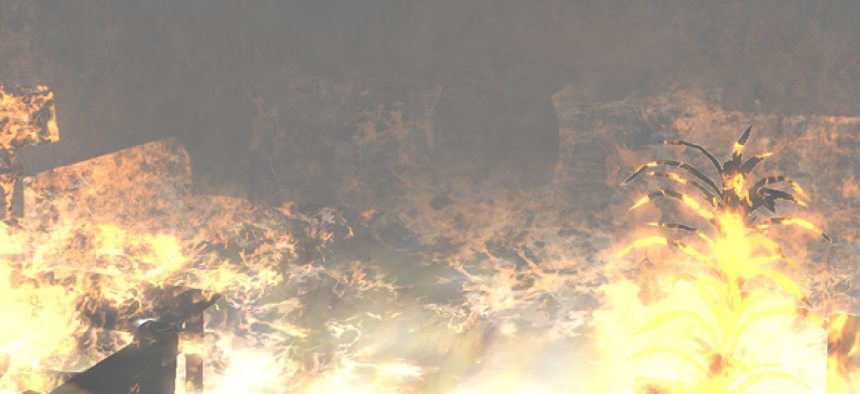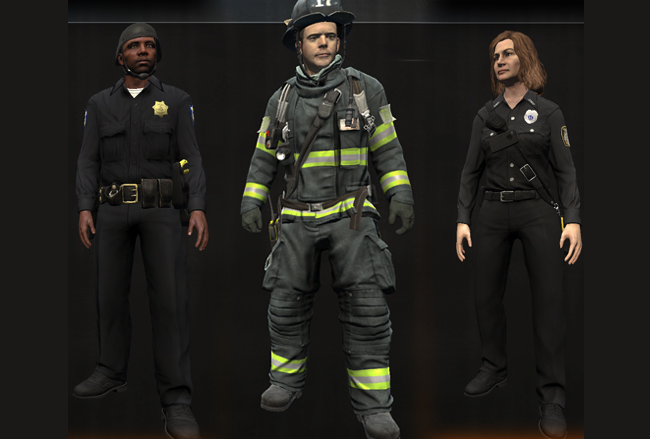DHS-Army game engine gives first responders an EDGE

The Enhanced Dynamic Geo-Social Environment joint virtual training platform supports scenarios in which multiple organizations must coordinate with each other, as would be necessary in an active-shooter scenario.
The military has used virtual simulations since at least World War I to train personnel. The first known such device, called the "Antoinette," was developed in 1909 and was rigged with levers and wheels to teach pilots to control pitch and roll before actually taking to the air.
Virtual simulators have come a long way.
EDGE (Enhanced Dynamic Geo-Social Environment), the product of a joint effort by the U.S. Army and the Department of Homeland Security intended to train military and first responders, debuted with a live demonstration by the Sacramento, Calif., police and fire departments last November. As a result of feedback from that demonstration, DHS plans to offer the application to other agencies and departments in early 2014.
EDGE presented Sacramento first responders with a double threat: A half-dozen terrorists surge into a downtown hotel, firing on civilians. As police arrive, the terrorists set fires in the lobby and on an upper floor. The command center must coordinate police, fire and emergency medical responses.
"The environment is very realistic," Chris Costamagna, battalion chief of the Sacramento Fire Department, told GCN. "We've never seen anything like it."
Leveraging resources
According to John Verrico, chief of media relations for DHS's Science and Technology Directorate, the joint effort came about as a result of feedback from first responders themselves.
"We kept hearing over and over again from the emergency response community that what they needed was a good virtual training platform," Verrico said. While organizations had their own training tools, they didn't have a program that supported scenarios in which multiple organizations coordinated with each other, as would be necessary in a real crisis. "And the scenario they told us they needed the training on the most was on an active-shooter scenario," Verrico said.
Knowing that the Army had done work on active-shooter simulations, DHS reached out to the Army's Training and Doctrine Command (TRADOC) in late 2012.
"With a limited budget, we have to look at leveraging our investment with other agencies," said Christine Lee, program manager at DHS’s Science & Technology Directorate. "The U.S. Army is the leading federal agency in the development of these virtual-training tools, so we reached out to them. We're basically leveraging our multimillion dollar Army investment to develop a realistic tool."
According to Matt Kaufman, chief of the Technology and Innovation Division of TRADOC, the Army was already working on an active-shooter simulation running on the Unreal Engine 3 game engine. "Instead of trying to pay for the development costs we wanted to leverage the capabilities of a commercial product but ensure through our efforts that it supports the government," Kaufman said. "We're leveraging what the commercial industry does very, very well."
And while EDGE is PC-based, it is flexible in its connectivity. "We can connect to a Wii device or a game controller," Kaufman said. "Our goal is not to pick a single solution but to provide a capability that gives the users the flexibility to focus on what is important to them."
Through 2013, a joint team of about 80 developers, including artists, worked to create a 3D scenario – scripted in cooperation with Sacramento first responders – and to populate it with avatars and equipment that reflected the conditions in Sacramento.
No simple game
EDGE is no simple shoot-'em-up game. For one thing, players can't simply keep shooting. They enter the game with limited ammunition and, unless they are resupplied, they will run out. And the goal of the players isn't just shooting. It's all about resource management and communications. The equipment available in the scenario is the equipment actually available to first responders in Sacramento.
"We created a sandbox around a multi-story hotel in a city environment. We did not build the actions that occurred inside that hotel," Kaufman said. "We were trying to ensure that we could give Chief Costamagna and the first responders of Sacramento an environment that they could train in the way that they wanted to train."
By making relatively small changes, however, developers can adapt the program to other cities. "We can still take that hotel and go to New York and allow New York firefighters and police to tackle the same problem using their own standard operating procedures," Kaufman noted.
The DHS/Army team has also added capabilities not found in most games. For the Sacramento scenario, for example, the developers added a realistic fire element.
"If you look at commercial games, fire is usually an art effect. It doesn't have damage effects," said Tami Griffith, associate branch chief at the Army's Simulation & Training Technology Center. "What you see in the DHS project is actual damage effects. If you walk into a fire without protective clothing or breathing apparatus you will be damaged very quickly."
And the more the fire is allowed to spread, the more water will be required to extinguish it. "You can't just splash water on the fire," said Milt Nenneman, program manager of DHS's First Responders Group. "You have to provide an appropriate amount of water relative to how big the fire is."
Nenneman's team also found that it takes three firefighters to drag a hose around, so EDGE reflects that. "So you have to get three firefighters to get together in concert driving their avatars to hook up the hose and then get the hose into the fire and then fight the fire," he said.
In short, the EDGE is all about communications and resource management.
One of the real benefits of this tool is that it has dual-level training," Kaufman said. "You have the tactical-level training for individual firefighters and officers as they go about doing their jobs of putting out the fire and actively engaging the shooter. And you also have the strategic level, which is the unified command. It deals with resource allocation, the decision on what tactics to employ."
In real situations, Costamanga said, "it is resource allocation and accountability that command will be challenged with." Those factors are precisely what EDGE highlights, he noted.
"The EDGE environment gives you a chance, not only to train on what you're going to do when you get to a crisis scene, but for us in Sacramento it also gives us a chance to train with our law enforcement brothers and sisters," he added. With EDGE, he said, "We trained 20 people in a time period that usually would take us a month. It was very powerful for us."
Deploying EDGE
After the success of the Sacramento exercise, DHS is eager to enhance EDGE and to offer it to other jurisdictions. "We are right now in the process of trying to get some additional funds to not only harden the Sacramento active-shooter scenario and to distribute to users, but also to supplement funding to build a school model so that first responders and school staff can train for an active-shooter incident," Lee said.
And one of the best things about EDGE, she notes, is that it's free to first-responder organizations. While the Sacramento scenario cost DHS-ST $3.2 million to develop, the resulting product is being offered free of charge.
Development of additional scenarios, of course, will require additional funding. "The way we approach this, Kaufman said, is we say, 'Here is what we have right now. It is already funded and the government owns it. If this is good enough then you don't have to spend anything but a little bit on the backend to organize the users and then you can login. If you want something we have not touched at all, we have to sit down and do a requirements analysis."
According to Kaufman, development of the Sacramento scenario involved two visits over four or five days to make sure developers understood the requirement. "It is sausage-making in its purest form," he said.








